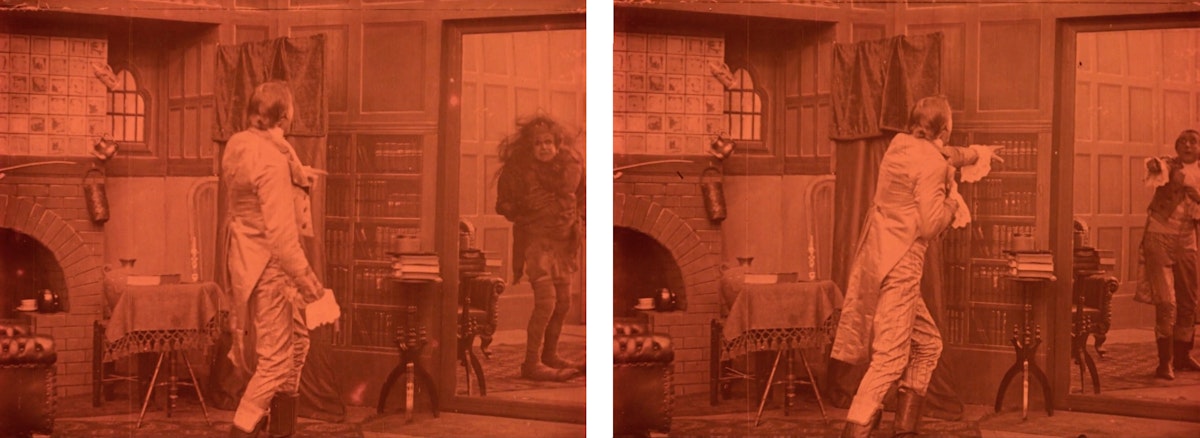
Frankenstein (1910)
This 1910 Edison Manufacturing Company production, newly restored by the Library of Congress, is the only extant nitrate print of the first film adaptation of Mary Shelley’s Frankenstein. Subtitled “a liberal adaptation”, Frankenstein bears only a vague resemblance to its source text. Directed by J. Searle Dawley and shot in three days, the film downplays the social aspects of Shelley’s novel in favor of a story about the creature as an uncanny doppelgänger of its creator. “Instead of a perfect human being”, the intertitles tell us, “the evil in Frankenstein’s mind creates a monster.” Rather than being “born” innocent and made monstrous through the dark mirror of prejudice, this creature is violent by design. His creation in what looks to be a steaming cauldron or crucible — staged with still-terrifying special effects, as he waves a semi-animate arm — anticipates the creepy mechanical bodies of later horror villains such as Chucky and Jigsaw. And yet, once the creature assumes its human form, he looks more like a lost member of Kiss. The film culminates with a kind of integration of Frankenstein’s shadow material, with a plot device that feels closer to Oscar Wilde’s Picture of Dorian Gray than Shelley’s Frankenstein. Escaping into a mirror, the creature looks back at his creator. Suddenly, he vanishes with a jump cut, and Frankenstein is left pointing an accusatory finger at himself.
 Scroll through the whole page to download all images before printing.
Scroll through the whole page to download all images before printing.
Part of the “monstrous” nature of Shelley’s novel is its bricolage form. Like the creature himself, we read a patchwork story composed of different nested accounts, letters, and voices. The book only comes “alive” under the reader’s attentive observation, as we work to create a unity out of scavenged parts. Of course, translating this story from text to film requires accommodation, but something of the same effect might have been achieved through the kind of psychological techniques employed by Akira Kurosawa in Rashomon (1950): using the uncertainty of subjective memory and visual perspective to preserve Shelley’s ambiguities. This is asking a lot of a ten-minute silent film created in 1910. Yet its legacy is perhaps partly to blame for the violent intensifications of subsequent filmic adaptations of this novel, such as The Curse of Frankenstein (1957), where the creature is less a Miltonian Satan, more simply satanic.
None of this mattered to contemporary audiences, for the film was well-received primarily because of its infidelity. A review in the Fairmont West Virginian noted how the filmmakers “carefully tried to eliminate all the actually repulsive situations and to concentrate its endeavors upon the mystic and psychological problems that are to be found in this weird tale”. Wherever the story was changed, the reviewer proceeds to note, it is solely for the benefit of motion picture audiences — and the results spoke for themselves. Writing about the creation scene, he calls it “probably the most weird, mystifying and fascinating scene ever shown on a film.” Salt Lake City’s Herald-Republication agreed: “the scene in the laboratory where the monster seems to gradually assume human semblance is probably the most remarkable ever”.
 Scroll through the whole page to download all images before printing.
Scroll through the whole page to download all images before printing.For audiences today, the story of this nitrate print’s acquisition is almost more exciting than the film it contains, notes Wendi Maloney. It was unknowingly acquired by Alois F. “Al” Dettlaff of Wisconsin — remembered for dressing as Father Time at cinema conventions, complete with scythe and hourglass — as part of a larger trove in the 1950s. Only when the American Film Institute put Frankenstein on its list of lost movies in 1980 did Dettlaff realize what he had been sitting on. From there, the Library of Congress recovered the missing credits from the Edison Company’s archives, and commissioned a composer to score the film.
Aug 2, 2011








